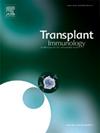Cuproptosis gene characterizes the immune microenvironment of diabetic nephropathy
IF 1.4
4区 医学
Q4 IMMUNOLOGY
引用次数: 0
Abstract
Background
The cuproptosis is an intracellular copper (Cu) accumulation triggering the aggregation of mitochondrial lipoylated proteins and destabilization of iron‑sulfur (Fe![]() S) cluster proteins, leading to cell death. This copper-triggered modality of mitochondrial cell death has been associated with cuproptosis-related signature key genes (CRGs). Our study focused on the relationship between the cuproptosis CRGs and diabetic nephropathy (DN) to understand how such immune microenvironment may influence DN.
S) cluster proteins, leading to cell death. This copper-triggered modality of mitochondrial cell death has been associated with cuproptosis-related signature key genes (CRGs). Our study focused on the relationship between the cuproptosis CRGs and diabetic nephropathy (DN) to understand how such immune microenvironment may influence DN.
Methods
We downloaded and compared RNA sequencing data sets of DN glomerular tissue samples vs. normal renal tissue samples (GSE142025, GSE30528, and GSE96804) from Gene Expression Omnibus (GEO) database. Differentially expressed genes (DEGs) between DN and control samples were screened. Immune cell subtypes infiltration and immune score were figured out via different algorithms. Consensus clustering was performed by the Ward's method to determine different phenotypes of DN. CRG key genes between two phenotypes were identified via machine learning algorithm. Logistic regression analysis was applied to establish a nomogram for assessing the risk of DN.
Results
In DN samples, two genes NLRP3 and CDKN2A were positively correlated to the immune score. In contrast, six genes NFE2L2, LIAS, LIPT1, DLD, DBT and DLST were negatively correlated to the immune score. Via Consensus clustering based on cuproptosis CRG key genes, the DN samples were divided into cluster C1 and cluster C2. The cluster C1 was characterized by low cuproptosis CRG genes expression, high immune cell subtypes infiltration, and high enrichment of immune-related pathways. Cluster C2 was on the contrary, the Dicarbonyl/l-xylulose reductase (DCXR) and heat-responsive protein 12 (HRSP12) genes were related to clinical traits and the immune microenvironment, negatively correlated with most immune cell subtypes. The nomogram was constructed based on DCXR and HRSP12 showing good efficiency for the DN diagnosis.
Conclusion
We conclude that the immune microenvironment imbalance and metabolic disorders lead to the occurrence of DN. The signature cuproptosis genes, regulating the immune microenvironment and metabolism, represented the DN disease clustering to describe the heterogeneity and characterize immune microenvironment. Both HRSP12 and DCXR key genes are related to DN disease phenotypes and immune microenvironment characteristic and may help in DN diagnosis.
糖尿病肾病的免疫微环境特征是铜变基因。
背景:铜沉积是一种细胞内铜(Cu)的积累,引发线粒体脂酰化蛋白的聚集和铁硫(FeS)簇蛋白的不稳定,导致细胞死亡。这种铜触发的线粒体细胞死亡方式与铜增殖相关的特征关键基因(CRGs)有关。我们的研究重点是铜肾病与糖尿病肾病(DN)之间的关系,了解这种免疫微环境如何影响DN。方法:从Gene Expression Omnibus (GEO)数据库下载DN肾小球组织样本和正常肾组织样本(GSE142025、GSE30528和GSE96804)的RNA测序数据集并进行比较。筛选DN与对照样品之间的差异表达基因(DEGs)。通过不同的算法计算免疫细胞亚型浸润和免疫评分。一致聚类通过沃德的方法来确定不同的DN表型。通过机器学习算法鉴定两种表型之间的CRG关键基因。采用Logistic回归分析建立评估DN风险的nomogram。结果:在DN样本中,NLRP3和CDKN2A两个基因与免疫评分呈正相关。NFE2L2、LIAS、LIPT1、DLD、DBT和DLST 6个基因与免疫评分呈负相关。通过基于铜protosis CRG关键基因的Consensus聚类,将DN样本分为C1类和C2类。C1簇的特点是低铜化CRG基因表达,高免疫细胞亚型浸润,免疫相关通路高度富集。C2簇则相反,二羰基/l-木糖还原酶(DCXR)和热反应蛋白12 (HRSP12)基因与临床特征和免疫微环境相关,与大多数免疫细胞亚型呈负相关。基于DCXR和HRSP12构建的nomogram对DN有较好的诊断效果。结论:免疫微环境失衡和代谢紊乱导致DN的发生。调节免疫微环境和代谢的标志性cuprotosis基因代表了DN疾病的聚类,描述了免疫微环境的异质性和特征。HRSP12和DCXR关键基因均与DN疾病表型和免疫微环境特征相关,可能有助于DN的诊断。
本文章由计算机程序翻译,如有差异,请以英文原文为准。
求助全文
约1分钟内获得全文
求助全文
来源期刊

Transplant immunology
医学-免疫学
CiteScore
2.10
自引率
13.30%
发文量
198
审稿时长
48 days
期刊介绍:
Transplant Immunology will publish up-to-date information on all aspects of the broad field it encompasses. The journal will be directed at (basic) scientists, tissue typers, transplant physicians and surgeons, and research and data on all immunological aspects of organ-, tissue- and (haematopoietic) stem cell transplantation are of potential interest to the readers of Transplant Immunology. Original papers, Review articles and Hypotheses will be considered for publication and submitted manuscripts will be rapidly peer-reviewed and published. They will be judged on the basis of scientific merit, originality, timeliness and quality.
 求助内容:
求助内容: 应助结果提醒方式:
应助结果提醒方式:


